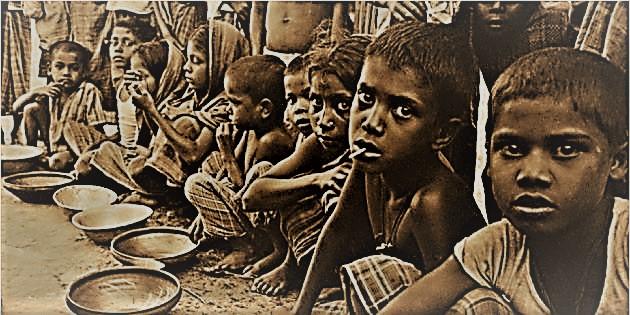India Far from Achieving SDGs to Eradicate Poverty, Hunger, and Inequality

The index is aimed at measuring the performance of the country with respect to the United Nations-mandated SDGs. The latest edition made it clear that India is far from achieving some of its goals.

The Poor Got Poorer
The Index showed that India is far from achieving the first goal—no poverty by 2030. India’s overall score of 50 (out of 100) in this respect was lower than 54 in the past year. All the states in the country saw decline in their scores, with Andhra Pradesh and Sikkim being the only exceptions with the increase of two and one score points respectively. Among the Union Territories, Lakshadweep, Delhi, Chandigarh, and Dadra and Nagar Haveli saw increase in score, though the last two fell in the ‘aspirant’ category, with scores below 49. The global targets for this SDG are:
1. By 2030, reduce at least by half the proportion of men, women and children of all ages living in poverty in all its dimensions according to national definitions.
2. Implement nationally appropriate social protection systems and measures for all, including floors, and by 2030 achieve substantial coverage of the poor and the vulnerable.
3. By 2030, ensure that all men and women, in particular the poor and the vulnerable, have equal rights to economic resources, as well as access to basic services, ownership and control over land and other forms of property, inheritance, natural resources, appropriate new technology and financial services, including microfinance.
Among the states, Arunachal Pradesh plummeted the most, by 18 points, while Bihar and Odisha slipped by 12 points each. Goa and Jharkhand declined by nine points. Only six states were in the ‘front runner’ category, having scores between 65 and 99. These six states were Tamil Nadu, Tripura, Andhra Pradesh, Meghalaya, Mizoram, and Sikkim. Eight states were in the ‘performer’ category with scores between 50 and 64. The highest number of states fell in the ‘aspirant’ category. The worst performing states were Jharkhand, Bihar, Arunachal Pradesh, Uttar Pradesh, Madhya Pradesh, Manipur, Odisha, Maharashtra, Haryana, and Gujarat.
Growing Hunger
In October 2019, the Global Hunger Index pointed out that India had slipped to rank 102 out of 117 countries analysed in the Global Hunger Index (GHI) 2019. The country had slipped behind the neighbouring countries of Sri Lanka, Nepal, Pakistan, Bangladesh, and Myanmar. The SDG Index pointed out that the condition in the country was worse than it was in 2018. India’s score decreased from 48 in 2018 to 35 in 2019. The global targets for the Zero Hunger SDG are:
1. By 2030, end hunger and ensure access by all people, in particular the poor and people in vulnerable situations, including infants, to safe, nutritious and sufficient food all year round.
2. By 2030, end all forms of malnutrition, including achieving, by 2025, the internationally agreed targets on stunting and wasting in children under 5 years of age, and address the nutritional needs of adolescent girls, pregnant and lactating women and older persons.
3. By 2030, double the agricultural productivity and incomes of small scale food producers, in particular women, indigenous peoples, family farmers, pastoralists and fishers, including through secure and equal access to land, other productive resources and inputs, knowledge, financial services, markets and opportunities for value addition and non-farm employment.
India’s score of 35 makes it fall in the ‘aspirant’ category. Only seven states were in the ‘front runner’ category, namely Goa, Mizoram, Kerala, Nagaland, Manipur, Arunachal Pradesh, and Sikkim. The ‘performer’ category had just one name, Punjab. The remaining 20 states fell in the ‘aspirant’ category, with the worst performing states being Jharkhand, Madhya Pradesh, Bihar, Chhattisgarh, Uttar Pradesh, Odisha, Maharashtra, Rajasthan, Meghalaya, Andhra Pradesh, Telangana, Karnataka, and Gujarat. Jharkhand saw a decrease of 13 score points between 2018 and 2019, while Madhya Pradesh saw a decrease of 17 points.
Among the UTs, Chandigarh and Puducherry fell in the ‘front runner’ category, and Dadra and Nagar Haveli, Andaman & Nicober Islands, and Daman Diu fell in the ‘aspirant’ category. Daman and Diu’s score decreased from 42 in 2018 to 12 in 2019.
Increased Inequality
Reduced Inequality is one of the SDGs that India is supposed to achieve by 2030. The global targets for this goal are:
1. By 2030, progressively achieve and sustain income growth of the bottom 40 percent of the population at a rate higher than the national average.
2. By 2030, empower and promote the social, economic and political inclusion of all, irrespective of age, sex, disability, race, ethnicity, origin, religion or economic or other status.
3. Adopt policies, especially fiscal, wage and social protection policies, and progressively achieve greater equality.
While the ‘front runner’ category consisted of as many as 16 states for this goal, India’s score decreased from 71 in 2018 to 64 in 2019. The ‘performer’ category had eight names, while four states fell in the ‘aspirant’ category. These four states were Uttar Pradesh, Tripura, Arunachal Pradesh, and Goa. Goa saw a decrease of 31 points, from 50 in 2018 to 19 in 2019. Arunachal Pradesh’s score decreased from 47 in 2018 to 38 in 2019. Tripura’s score saw a shocking decline, from 89 in 2018 to 45 in 2019. Among UTs, Chandigarh was the worst performer, with a score of 33, a decline of 19 points from 2018.
India saw a decrease in scores for several other SDGs, like Decent Work and Economic Growth, and Life on Land between the years 2018 and 2019. The score for the goal of Quality Education remained the same. The goals where India saw an increase in scores were Good Health and Well-being, Gender Equality, Clean Water and Sanitation, Affordable and Clean Energy, and Sustainable Cities and Communities.
Get the latest reports & analysis with people's perspective on Protests, movements & deep analytical videos, discussions of the current affairs in your Telegram app. Subscribe to NewsClick's Telegram channel & get Real-Time updates on stories, as they get published on our website.
























